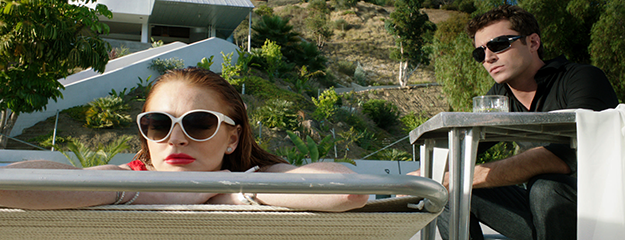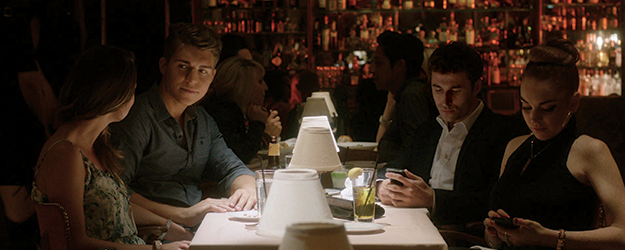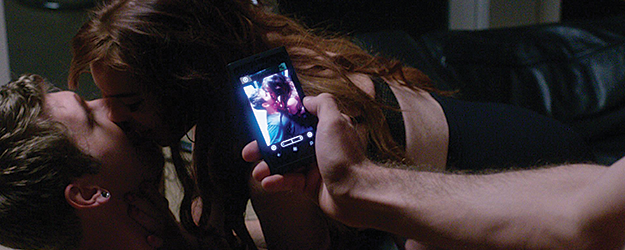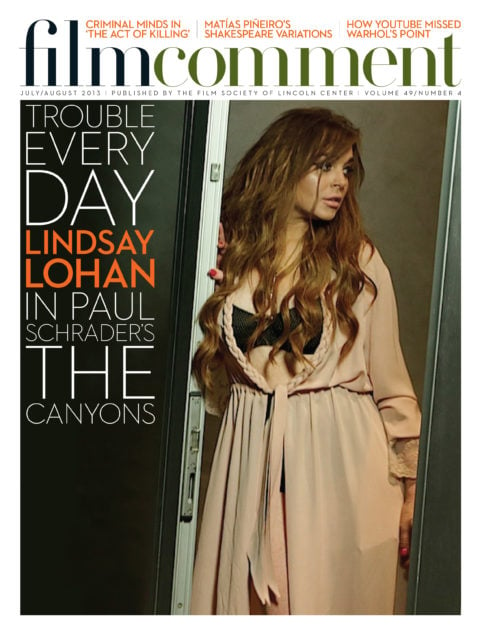The Canyons is a compelling, twisted film about sex, career, money, and power in contemporary Hollywood. But the story, while edgy and intricate with deceit and betrayal, is a means to another end. Paul Schrader’s new movie paints a convincing picture of this cultural moment, a post-economic-crash digital age in which anyone driving a fancy car and flashing a credit card may or may not be an “indie” film producer, and sexual and professional commitments are as fragile and ephemeral as sea breezes.
Forty years ago, as a would-be film journalist just out of college, I interviewed Schrader. He was astonishingly articulate and quietly confident. With good reason, as it turned out: later that week a film he had written, directed by Martin Scorsese and starring Robert De Niro, had its New York premiere. It was as if Schrader knew that he and his friends were about to make film history.
I met Schrader again 20 years later when we both had films at the 1997 Venice Film Festival. His was Affliction, and I was pleased to be able to tell him that I thought it was his finest and most personal work as a director so far. He modestly gave most of the credit to the source novel by Russell Banks. My three favorite Schrader-directed films originate with strong source material: Affliction, Mishima (85), and now The Canyons, from an original screenplay by Bret Easton Ellis.
I saw The Canyons a couple of days after Baz Luhrmann’s The Great Gatsby and I was struck by the similarity of their plots. A poor guy vies with a rich guy for the heart of a flawed princess. The bloody dynamics of a crime story exist on the edge of the action without ever quite taking over. Everyone is seduced and corrupted and driven to one degree or another by the power of money, and ultimately no one gets what they want. Every material object or career goal eludes, mocks, or disappoints the desire it incites. I enjoyed Luhrmann’s movie, but I liked The Canyons more. Fitzgerald had one stupendous insight that has ensured his book’s relevance today: Gatsby is a “virtual” personality, a tissue of constructed impressions and wild rumor, almost born for the Internet. This virtual reality has become simply our reality. In The Canyons, Schrader and Ellis depict it as a chronically empty, zombie-like zone of blankness and frustration, and they do it with uncanny, dreadful precision.

You’d have no reason to remember this, but I interviewed you for a magazine sometime in 1976. What you were preoccupied with from a career perspective at that point was an imminent opportunity to make your directorial debut with Rolling Thunder. You were learning the commercial side of filmmaking.
I mean, I wasn’t! I was learning to figure out how to stay in it. If I really cared about being rich, I’d have been very rich a long time ago. Because everyone I knew was getting rich. And I knew how they were getting rich. But getting rich was never part of the game. The game was being able to work. After I got fucked on Rolling Thunder, I started figuring out how to piece it together without a sugardaddy at the studio. How to write a script for three B-level actors who together would constitute one A-level actor. How to write something they would be attracted to for minimum wage. That was Blue Collar. I knew Lucy Saroyan, who had had an off-and-on thing with Pryor, and I knew Harvey. And then my former agent was working at Norman Lear’s company T.A.T., and Lear always had an interest in socially progressive material, so the idea of doing a film like that at the time appealed to him. And then T.A.T. brought in Universal, so the film was financed from the ground up.
How did The Canyons happen?
There was a script by Bret called Bait, essentially a kind of horror-ish—well, somewhat whore-ish as well—shark movie that was being financed by some Spanish money, to be shot in San Juan with Anton Yelchin and Emmy Rossum. Then the Euro and the Spanish economy took a hit, and about four weeks before shooting, the project took a dive. This was my second in a row that had gone down this way.
Bret was frustrated, so I said, it’s getting so cheap to make films, why don’t you write one, I’ll direct it, we’ll pay for it, and we’ll just do it. And the next thing I knew he was working on it. I have a feeling that it was something he had pitched at one point. I told Bret: “What you do isn’t that expensive. Beautiful people, nice rooms, bad things, and sharp talk. How expensive is that?” I told him to write the script as a micro-budget. That is, don’t write a regular script and then try to do it for nothing. Write a script that’s designed for this, which means for instance that we didn’t pay for any locations. The opening scene is at the Chateau Marmont, and we both knew people there, and we gave the manager a small role—he’s an actor, too. And so it had to be written with those kinds of locations in mind, and couldn’t involve anything that would cost money: action, stunts. Bret was very concerned that it not look like a home movie. But we had enough connections.
How much of the story had he worked out with you?
None. I think he sent me an e-mail saying: “You know, it’s about these kids in the wrong business.” And I told him the essential structure, the Renoir structure of the rotating triangles—you take two triangles, connect them at one point, and let them turn. So you have the triangle of Christian, Tara, and Ryan, and then you have the triangle of Christian, Cynthia, and Ryan. That puts Christian at the center of the two triangles, and whenever the points of the triangles meet, you’ve got interesting scenes. Bret worked very quickly. Probably no more than a month.
And then it kind of grew from there. Since our motto was “We don’t pay for things,” we had to figure out how to cast it. Because you’re looking for five attractive, young, talented actors who will do nudity and sex simulation and work for micro-budget SAG wages, which is literally minimum wage, $7.80 an hour. You’re paying them $100 a day. I asked the person who was casting Bait, “What would you do?” and she said, “Why don’t you try Let It Cast?” Let It Cast is an online casting service, and you put up your scenes and film yourself discussing the scenes and the character. Anyone can shoot themselves performing the scene and then post it, and then you’ll see it. And those auditions are still in the cloud somewhere. For the first two weeks the auditions were kind of terrible. And then after two weeks, quality ones started coming in. The word was going out through the grapevine. Los Angeles is full of actors looking for that break. We got 648 auditions from around the world. And of these, I would estimate that maybe 125 were of professional quality. We were on the verge of casting the entire film this way.
Our first choice was a really hot actress named Monica Gambee who did a terrific test. I met with her and pretty much committed to casting her [as Tara]. And I came out to screen-test her. And it turned out this was the same day we were going to screen-test James Deen. Bret is a very promiscuous Twitter figure and he had tweeted: “I’m writing a script now and the main character is sort of modeled on male porn star James Deen.” James read that and tweeted back, “Well, I can’t wait to read it.” So they had lunch. Bret was very taken with him—James is straight and Bret is in a relationship, so it wasn’t a sexual thing, but it was a starstruck kind of thing. Bret promised I would screen-test him. And I rolled my eyes, because, you know, it’s this guy who had done like 3,000 porn films. That’s a lot of bad acting to get out of somebody’s system. So we were going to screen-test Monica with James. And when she found out that she was going to do a test with a porn actor, she refused to do it. I was so struck by how good she was that I guaranteed her that I would not cast James if she would come. But she wouldn’t do it. We met with Lindsay for the character of Cynthia. We figured that since she has three or four scenes, we could probably shoot them all in one lump. And if we got lucky, if we had Lindsay there, we could just shoot her out. Because everyone was worried about her reputation, her unreliability. We met with her and she said, “I don’t want that role, I want the lead.” We started to see where we could make this idea of “discard casting”—using people that other people won’t hire—work for us.
And then the people from Let It Cast said, “Why don’t you go on Kickstarter?” And we said, “Kickstarter is for people who don’t have any money. We have enough money to make this.” And they said, “You can get at least $100,000 from Kickstarter. Don’t you want to make a better movie with that?” And so in the end we made $170,000, which, along with the $90,000 we put in, turned out to be just the right amount. The truth is that if we had had three times as much money, it probably wouldn’t have ended up on the screen, because we would have started paying for things that we were refusing to pay for. You start paying for locations. You start paying for car rentals. Fortunately James had a $90,000 car. We weren’t going to pay for one. But part of the fun of The Canyons was, can you make a film this way? Is this now possible?
This is cinema for the post-theatrical era. And people complained that the film was going to go straight to video. Well, we said: “Let’s make something that’s not for theaters.” It will have a theatrical release. But it’s going to have day-and-date. The whole motif of the derelict movie theaters was there right from the beginning.
Bret has this post-Empire idea. He believes that American artists are now in their post-Empire period. Like the Brits were in the previous century. So we’re making art out of the remains of our empire. The junk that’s left over. And this idea of a film that was crowd-funded, cast online, with one actor from celebrity culture, one actor from adult-film culture, a writer and director who have gotten beaten up in the past—felt like a post-Empire thing. And then everything I was afraid of with Lindsay and James started to become a positive. I was afraid we wouldn’t be taken seriously and people would think it’s a joke. My son and my daughter didn’t want me to do it. This just shows you how conservative young kids are. Because they thought it would be embarrassing and a disaster.
The number-one fact of the new low-budget cinema is that it is no longer impossible to get your film financed, but it is impossible to get anybody to see it. Because there are 10,000 people doing the same thing you’re doing, right now. And which one of those 10,000 films is anybody going to see? Fifteen thousand films get submitted to Sundance, 100 or so get shown, eight get picked up, and two make money. Those are the economics. But Bret and I have some cachet. We were in with four different sub-groups of interested people: people who are interested in me, people who are interested in Bret, people who are interested in Lindsay, and people who are interested in James. Lindsay has four million [Twitter] followers, and James has half a million. Bret has 250,000.

How do you see your career in light of your experience on this film?
I went to the casino, I put it all on red, and it came up red. We got lucky with this one. We got lucky with James, we got lucky with Lindsay. We got lucky with the noise factor. When you’re pitching a movie, that’s the question they ask: is it going to make noise? Are you going to hear this above the din of the avalanche of film productions? And if the idea has noise, then they are interested in it. And this idea had noise. Some of it by design, some of it by luck. That’s why I went to Bret, because if it was the two of us together it was going to make noise.
Obviously, Lindsay didn’t have a problem with James Deen.
Oh yes, she did.
When did you announce that her co-star was somebody from the adult industry?
When we first met with her. In fact, she was trying to get him out. The first read-through, I looked over at her notepad and she was making a list of other actors who could play these roles. I said, “Lindsay, I’m not gonna let you recast this movie.” She was always wary of Deen. A little bit because of the porn thing, but also her fear was that he would steal her thunder. That he would be higher profile, a bigger story. A better story. Lindsay is a complicated subject.
I think the Adderall, more than anything else, is the problem. It’s a very fashionable drug in young Hollywood. It’s supposedly for attention deficit disorder. And it can be. But it is now a drug that is more abused than used. They use it for weight loss. They use it for energy. It’s basically a kind of speed. I never quite understood it. At 4 or 5 in the morning, people were trying to get out of her room. And she didn’t want them to leave. She didn’t want to be alone. I thought: “How do you do that without cocaine?” She’s not doing cocaine, I can tell. I know she’s not. I said I don’t know how she does it. Now I know [chuckles].
What do you think makes the characters in The Canyons interesting?
They are of our moment. They feel focused in this moment. It feels like 2013 to me. It’s a blank generation kind of thing: “We’re doing things that we want to do and we don’t care about it but we’re doing it anyway. I’m buying all these clothes, it doesn’t mean anything, but it’s the only thing I feel like doing.” It’s not where I came from. A lot of the characters that I began writing are dated. Taxi Driver has become a classic, but it’s a classic in a historical context.
The specter of poverty hovers over this world of lavish people, the sense that it’s just around the corner. Is that part of the 2013-ness of it?
Yeah. This world of appearances, still believing in appearances, like still believing in movies when you don’t believe in them anymore. But the option of not believing in appearances is too frightening. You don’t believe in the thing you believe in, because you’re afraid of not believing in it. And it means nothing. It’s not like believing in God because you’re afraid of not believing in God.
There’s also a sense of the exhaustion of affluence.
Yeah, and now what appears in Bret’s work as the affluence of the Eighties and American Psycho, has been ratcheted up a notch with the affluence of technology, which is another kind of a soul-numbing materialism.
How do you want us to think about the murder that Christian commits? What is the connection between this act and his visit to his psychiatrist?
Christian is humiliated after the four-way. And he’s got his murder clothes on when he visits the psychiatrist. So he’s dressed to kill.

There’s something about Christian talking to the shrink about his father that releases in him the impulse to kill.
Yeah. He wants to punish Tara, but he can’t do that, so he has to punish Cynthia. I never asked Bret about it. I just assumed that it’s a father issue. The other adaptations of Bret’s books all become weak when the fathers show up because once they’re in front of you they’re not all-powerful anymore.
You know that painting on the wall in the psychiatrist’s office? The scene ends and it racks focus to this painting of this man looking down at Christian. And it’s T.S. Eliot. The original Hollow Man. Eliot was so big in my background. At Calvin College, where T.S. Eliot and C.S. Lewis were sort of seen as—
—the great Christian writers.
You could be an intellectual and a Christian, which was Calvinism. You could think your way to Heaven. Calvin spent his whole life reducing the window of faith to a pinhole, but of course a window or pinhole or barn door are all the same size when we talk about faith. Faith is faith.
Three of Ellis’s books have been made into movies, and they were failed films to one degree or another. I had the impression that those movies were all too big-budget. His world is more minimalist.
American Psycho is truest to his vision.
The only elements in Less Than Zero that work are the unredeemable characters.
The cinematography was too lurid. Bret’s world is much colder. I went through this argument with my cinematographer on The Canyons because he’s one of those guys who’s yellow from this direction, green from that direction. That’s all it is. I felt that the Bret World was colder than that. Lighting gels are the wrong way to go with this material. So we went for a much cleaner look.
The Canyons repudiates redemption, and accepts coldness. I think this is a successfully cold film.
When they rejected the film, South by Southwest said: “There’s a cold deadness to it.”
Seems more like a compliment. Because it’s the pinnacle of deadness. I think if American Gigolo had had just that little bit of deadness, it probably would have been a great film.
And maybe that’s what’s wrong with SXSW. But American Gigolo doesn’t age too well. It was very new at the time. Also, I did a stupid thing by grafting the end of Pickpocket onto it.
You once said that confronted with the realities of studio distribution and large-scale releases, you felt the need to regain your character. Or did you mean that in a religious sense?
I think it’s more of the latter. When I was a kid, I wanted to be a preacher. I went door to door, I was that kind of kid. And then I grew out of the church, but I didn’t grow out of the need to proselytize. So I found a different kind of soapbox. But I was still trying to reconcile my background with my new soapbox. I found myself in a period where I had a theological background and knew about films. The theological background was receding quickly, because you have to maintain it. I thought to myself, if I don’t write Transcendental Style right now, I’ll never write it, because five years from now, I’ll be even less plugged in, and I’ll care even less about these religious notions. So I wrote the book prematurely, because if I didn’t write it prematurely I wouldn’t write it at all.
I was thrown into screenwriting out of a psychological need to create fetish objects. Obsession [76] referenced Vertigo. Hardcore [79] referenced The Searchers. The Yakuza [74] referenced the yakuza genre. It was voodoo—it takes the pus out of your soul. That’s what Travis Bickle was. I intellectually felt threatened by him, and if I didn’t write about him, he was going to be an even greater force in my life. And that’s a perfect example of how art is functional. It can solve problems.
And I was always trying to redeem the characters in my scripts, and bring in this grace note. And show that my soapbox was as good as theirs. I could redeem people too. Although ironically, one time I was forced to change the ending of a script, and what happened on Hardcore made me swear that I would never do it again. The ending was really bleak, and Danny Melnick at Columbia insisted that he wouldn’t make the film. And the way the film ended then kind of riffed on Chinatown—this guy goes on this odyssey into the porn world to find his daughter, and at the end he discovers that she was killed in a car accident—and now he has filled his soul with all kinds of images and acts that he can never clean away. And like in the ending of Chinatown, the detective said to him, go home. There’s nothing you can do about it, you don’t belong here.
The father has that line in the film where he’s reconciled with his daughter.
I found that ending so deeply false. I’ve had to fight against all these attempts, and it drove me bit by bit out of the commercial mainstream, because you can’t keep fighting like that.
To me, The Canyons represents you succeeding at something you’ve done partially successfully before.
A lot of this had to do with luck. People ask why Taxi Driver has endured, and I say, “Luck.” Three people at the right time, right material, right mindset. It just clicked. Jeff Bridges wanted to do the film, but then it wouldn’t have happened. We got lucky on this one. Maybe the sheer craziness of the experience of trying to work with Lindsay and her condition, and the fact of “So what? We’re not on a tightrope.” I think if there had been an “adult” from a studio on the film, it would’ve been different.
You’ve had a career as a filmmaker and a steady and ongoing career writing, studying, and thinking about film in an analytical way.
I’m working on this long thing now for Film Comment, related to my class at Columbia on the history of film technology.
Has your intellectual study of film hurt your career?
I think so. I don’t think critics like filmmakers who know what they’re doing. They much prefer the John Fords of this world, who pretend not to know what they’re doing. Critics feel the need to solve it. If the director packages it too much, their reaction is to unsolve it, and prove the director wrong. I have been excessively verbal and excessively eloquent.
Is there anyone writing on film now who interests you?
I was watching that Schwarzenegger film The Last Stand on pay-per-view. It was pretty bad, and I wondered how this’d gotten reviewed. So I looked on Metacritic. There were 60 reviews from which I recognized only two of the publications. One was Variety, one was maybe the Sun-Times. And there were 58 reviewers out there, on websites. It’s not that I didn’t recognize the names of the reviewers, I didn’t recognize the names of the websites. And the truth is, these reviewers aren’t bad. But how do you get through that whole system? The New York Times has good reviewers, and The New Yorker, and those are the ones I read regularly. In some ways the film business is like an animal with four legs: there’s financing, audiences, artists, and critics. Well, the animal’s fallen. And one leg alone can’t get it up. Critics alone can’t lift that animal up. Artists alone can’t lift that animal up. People say, “If we only had better critics,” or “If we only had better films,” but you need all four legs to get that horse on its feet again.








